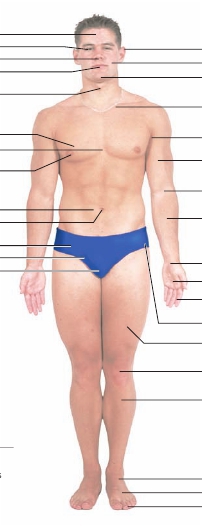16
PART 1 Organization of the Human Body

Head
Neck
Frontal (forehead)Orbital (eye)Nasal (nose)Oral (mouth)
Cervical
Otic (ear)Buccal (cheek)Mental (chin)
Clavicular (collarbone)
Thoracic(thorax)
Pectoral (chest)Sternal (breastbone)
Mammary (breast)
Axillary (armpit)
Brachial (arm)
Antecubital (front of elbow)
Trunk
Abdominal (abdomen)Umbilical (navel)
Pelvic (pelvis)Inguinal (groin)Pubic (genital)
Antebrachial (forearm)
Upper limb
Carpal (wrist)
Palmar (palm)
Digital (fingers)
Coxal (hip)
Femoral (thigh)
Patellar (kneecap)
Manual (hand)
(a)
Crural (leg)
Lower limb
FIGURE 1.10
Body Parts and Regions
The anatomical and common (
in parentheses
) namesare indicated for the major parts and regions of thebody. (
a
) Anterior view.
Talus (ankle)Dorsum (top of foot)Digital (toes)
Pedal (foot)
The central region of the body consists of the
head, neck,
and
trunk.
The trunk can be divided into the
thorax, abdomen,
and
pelvis.
The thorax is the chest cavity where the heart and lungs arelocated. The abdomen contains organs such as the liver, stomach,and intestines. The pelvis contains the bladder and reproductiveorgans. The upper limb is divided into the arm, forearm, wrist,and hand. The
arm
extends from the shoulder to the elbow, andthe
forearm
extends from the elbow to the wrist. The lower limbis divided into the thigh, leg, ankle, and foot. The
thigh
extendsfrom the hip to the knee, and the
leg
extends from the knee to theankle. Note that, contrary to popular usage, the terms
arm
and
leg
refer to only a part of the limb.The abdomen is often subdivided superficially into
quad-rants
by two imaginary lines—one horizontal and one vertical—that intersect at the navel (figure 1.11
a
). The quadrants formed arethe right-upper, left-upper, right-lower, and left-lower quadrants.In addition to these quadrants, the abdomen is sometimes sub-divided into
regions
by four imaginary lines: two horizontal andtwo vertical. These four lines create a “virtual” tic-tac-toe gridon the abdomen, resulting in nine regions: epigastric, right andleft hypochondriac, umbilical, right and left lumbar, hypogastric,and right and left iliac (figure 1.11
b
). Health professionals use the
quadrants and regions as reference points for locating underlyingorgans. For example, the appendix is in the right-lower quadrant,and the pain of an acute appendicitis is usually felt there.
Planes
At times, it is useful to describe the body as having imaginary flatsurfaces, called
planes,
passing through it (figure 1.12). A planedivides, or sections, the body, making it possible to “look inside”and observe the body’s structures. A
sagittal
(saj′i-t ă l)
plane
runs vertically through the body, separating it into right andleft portions. The word
sagittal
literally means “the flight of anarrow” and refers to the way the body would be split by an arrowpassing anteriorly to posteriorly. A
median plane
is a sagittalplane that passes through the midline of the body, dividing it intoequal right and left halves. A
transverse
(
horizontal
)
plane
runsparallel to the ground, dividing the body into superior and infe-rior portions. A
frontal
(
coronal
) (k ō r′ ŏ -n ă l, k ō -r ō ′n ă l; crown)
plane
runs vertically to divide the body into anterior (front) andposterior (back) parts.Organs are often sectioned to reveal their internal struc-ture (figure 1.13). A cut through the length of the organ is a